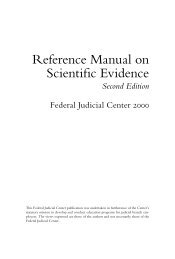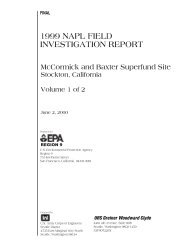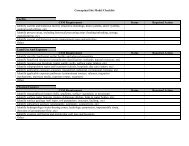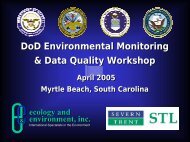- Page 1 and 2:
FinalSource Zone Delineation Demons
- Page 3 and 4:
EXECUTIVE SUMMARYThis report docume
- Page 5:
The SVE demonstration conducted in
- Page 8 and 9:
TABLE OF CONTENTSEXECUTIVE SUMMARY
- Page 10 and 11:
LIST OF FIGURESFigure ES-1 Iso-Conc
- Page 12 and 13:
Figure 5-38 Horizontal slices at fi
- Page 14 and 15:
LIST OF ACRONYMS AND ABBREVIATIONSA
- Page 16 and 17:
Hill Air Force BaseUtahRIVERDALEWeb
- Page 18 and 19:
Co-Team LeaderCo-Team LeaderURS Pro
- Page 20 and 21:
1.4 Report OrganizationThe remainin
- Page 22 and 23:
Davis-Weber CanalDetail AreaHillAir
- Page 24 and 25:
ANorthSouthU5-18864,580CROSS SECTIO
- Page 26 and 27: Approx. LocationOf BarrelsInitial S
- Page 28 and 29: Figure 3-2. Wireline locking and re
- Page 30 and 31: 3.3 DSITMS Soil AnalyticsDirect sam
- Page 32 and 33: 4.0 SOIL VAPOR EXTRACTION DEMONSTRA
- Page 34 and 35: The equilibrium four-phase distribu
- Page 36 and 37: 3520 ft. from well, 3.5 cfmTCE in E
- Page 38 and 39: The SVE system included piping from
- Page 40 and 41: SVE Process System and On-Site DSIT
- Page 42 and 43: Table 4-3. Summary of OU 12 SVE Ste
- Page 44 and 45: 3,000U12-VP1 Calibration Curve2,500
- Page 46 and 47: 5.0 RESULTS OF SOIL SAMPLING AND SV
- Page 48 and 49: 0U12-1802100U12-1803100U12-18051020
- Page 50 and 51: 0102030405060700U12-1804U12-1807102
- Page 52 and 53: Figure 5-4. Soil samples collected
- Page 54 and 55: 298400298360Northing (ft)2983202982
- Page 56 and 57: 298400298360Northing (ft)2983202982
- Page 58 and 59: The final TCE soil contamination mo
- Page 60 and 61: 298400298360Northing (ft)2983202982
- Page 62 and 63: Figure 5-12. Isometric view, lookin
- Page 64 and 65: An isometric view of the upscaled a
- Page 66 and 67: March 2003 5-21 OU 12 Demonstration
- Page 68 and 69: 4620WE460045804560454045204500Verti
- Page 70 and 71: 4620WE460045804560Elevation (ft)454
- Page 72 and 73: Volumetric calculations yield an es
- Page 74 and 75: The position of the water table in
- Page 78 and 79: Vapor Probe #1Vapor Probe #2Vapor P
- Page 80 and 81: Thus, the in situ air permeability
- Page 82 and 83: 0.0000-0.0010U12-VP1 ResponsePressu
- Page 84 and 85: 0.000020.00000U12-VP1 ResponsePress
- Page 86 and 87: Table 5-5. Estimated In Situ Air Pe
- Page 88 and 89: 10.0U12-VP1 Pneumatic Response8.0Ai
- Page 90 and 91: 1,400841,20072TCE Concentration (pp
- Page 92 and 93: 800.98700.84TCE Concentration (ppmv
- Page 94 and 95: 200.018180.016TCE Concentration (pp
- Page 96 and 97: 1400.491200.42TCE Concentration (pp
- Page 98 and 99: 4600OU12-VP1OU12-VP2 OU12-VP3 OU12-
- Page 100 and 101: the screened interval in U12-VP1 an
- Page 102 and 103: permeability layer. Final adjustmen
- Page 104 and 105: Table 5-7. Comparison of Measured a
- Page 106 and 107: Table 5-8. continuedFile Name Extra
- Page 108 and 109: U12-1802U12-VP3U12-1812U12-1803U12-
- Page 110 and 111: U12-1802U12-VP3U12-1812U12-1803U12-
- Page 112 and 113: U12-1802U12-VP3U12-1812U12-1803U12-
- Page 114 and 115: Figure 5-42 shows a comparison betw
- Page 116 and 117: U12-VP1 50 mg/kg source 10 ft thick
- Page 118 and 119: 5 10 15 20 25 30 35 40 455 10 15 20
- Page 120 and 121: 25 - 30 feet bgs30 - 35 feet bgs35
- Page 122 and 123: U12-VP1 200 mg/kg source 10 ft thic
- Page 124 and 125: A comparison between the predicted
- Page 126 and 127:
5 10 15 20 25 30 35 40 455 10 15 20
- Page 128 and 129:
U12-VP1 EVS Maximum Soil Concentrat
- Page 130 and 131:
9,200Predicted TCE Concentration (p
- Page 132 and 133:
6.1 Conventional Sampling and Analy
- Page 134 and 135:
Table 6-2. Estimated Cost for OU 12
- Page 136 and 137:
6.1.2 Direct Push Technology (DPT)T
- Page 138 and 139:
Table 6-4. Estimated Cost for OU 12
- Page 140 and 141:
that the Wireline CPT sampler canno
- Page 142 and 143:
Table 6-5. Summary of Estimated Cos
- Page 144 and 145:
The Wireline CPT tool is not effect
- Page 146 and 147:
Figure 7-1. Iso-concentration surfa
- Page 148 and 149:
24U12-VP5 Combined Testing201612846
- Page 150 and 151:
8.0 REFERENCESBear, J. 1979. Hydrau
- Page 152 and 153:
TABLE A-1FIELD ANALYICAL RESULTS FO
- Page 154 and 155:
TABLE A-1FIELD ANALYICAL RESULTS FO
- Page 156 and 157:
TABLE A-1FIELD ANALYICAL RESULTS FO
- Page 158 and 159:
TABLE A-1FIELD ANALYICAL RESULTS FO
- Page 160 and 161:
TABLE A-1FIELD ANALYICAL RESULTS FO
- Page 162 and 163:
TABLE A-1FIELD ANALYICAL RESULTS FO
- Page 164 and 165:
TABLE A-1FIELD ANALYICAL RESULTS FO
- Page 166 and 167:
TABLE A-1FIELD ANALYICAL RESULTS FO
- Page 168 and 169:
TABLE A-1FIELD ANALYICAL RESULTS FO
- Page 170 and 171:
APPENDIX BSimulated TCE Vapor-Phase
- Page 172 and 173:
TCE Concentration (ppmv2,4702,4602,
- Page 174 and 175:
U12-PV1Source Area #2TCE Concentrat
- Page 176 and 177:
U12-PV1Source Area #2250VP1 i=24, j
- Page 178 and 179:
U12-PV1Source Area #3TCE Concentrat
- Page 180 and 181:
U12-PV1Source Area #4TCE Concentrat
- Page 182 and 183:
TCE Concentration (ppmv4,9004,8004,
- Page 184 and 185:
TCE Concentration (ppmvTCE Concentr
- Page 186 and 187:
U12-PV1Source Area #6TCE Concentrat
- Page 188 and 189:
U12-PV1Source Area #7TCE Concentrat
- Page 190 and 191:
TCE Concentration (ppmv1,7301,7201,
- Page 192 and 193:
TCE Concentration (ppmv6,0005,0004,
- Page 194 and 195:
U12-PV1Source Area #8TCE Concentrat
- Page 196 and 197:
U12-PV1Source Area #9500450VP1 i=24
- Page 198 and 199:
TCE Concentration (ppmTCE Concentra
- Page 200 and 201:
700600U12-PV1Source Area #9VP1 i=24
- Page 202 and 203:
U12-PV2Source Area #1TCE Concentrat
- Page 204 and 205:
U12-PV2Source Area #3TCE Concentrat
- Page 206 and 207:
U12-PV2Source Area #7TCE Concentrat
- Page 208 and 209:
U12-PV2Source Area #7TCE Concentrat
- Page 210 and 211:
TCE Concentration (ppmv1,4001,2001,
- Page 212 and 213:
U12-PV2Source Area #7TCE Concentrat
- Page 214 and 215:
U12-PV2Source Area #7TCE Concentrat
- Page 216 and 217:
U12-PV2Source Area #8TCE Concentrat
- Page 218 and 219:
U12-PV2Source Area #8TCE Concentrat
- Page 220 and 221:
U12-PV2Source Area #10250VP2 i=23,
- Page 222 and 223:
U12-PV3Source Area #9TCE Concentrat
- Page 224 and 225:
U12-PV4Source Area #7TCE Concentrat
- Page 226 and 227:
U12-PV4Source Area #9TCE Concentrat
- Page 228 and 229:
TCE Concentration (ppm1.00.90.80.70
- Page 230 and 231:
U12-PV6Source Area #7TCE Concentrat
- Page 232 and 233:
U12-PV6Source Area #8TCE Concentrat
- Page 234 and 235:
U12-PV6Source Area #101816VP6 i=33,
- Page 236:
TCE Concentration (ppm6050403020100










